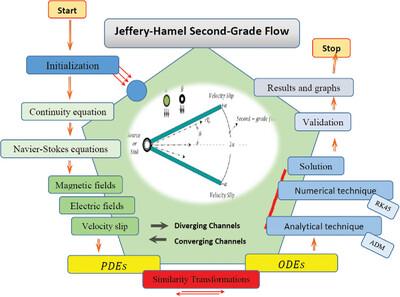Ohmic Dissipation on Jeffery-Hamel Flow of an Electrically Conducting Second-Grade Fluid in Converging and Diverging Channels Under Velocity Slip Effects: Semi-Analytical Simulations via ADM
IF 2.9
4区 工程技术
Q1 MULTIDISCIPLINARY SCIENCES
引用次数: 0
Abstract
Researchers can learn more about energy losses, temperature distributions, and general flow characteristics by examining the distribution of Ohmic dissipation in the channels under various circumstances. Thus, in this scientific investigation, it delves into the intricate dynamics of Jeffery-Hamel flow for second-grade fluids under the influence of velocity slip, magnetic, and electric fields. A transformative journey is set out using the electro-hydromagnetic second-grade fluid theory as the basis. The regulating partial differential equations responsible for this fluid flow phenomenon experience a significant transformation, evolving into ordinary differential equations. Then, two distinct but powerful analytical methods are used to analyze these ordinary differential equations: the widely used Adomian decomposition method and the 4th–5th order Runge-Kutta Fehlberg method, which is enhanced by the shooting operation. Various factors influencing the skin friction coefficient and the dimensionless velocity (represented as “f”) of the second-grade fluid are examined. The electric and magnetic fields, the Deborah number, and the elusive velocity slip components are among the many physical variables that are observed. The behavior of the fluid inside the channel is affected by these parameters in the same way that cosmic bodies are affected by gravity. As it delves deeper into the topic of fluid dynamics, and makes some interesting discoveries. The lowest parts of the channel exhibit significantly less backflow; indicating a distinct lack of it. Similar to start alignment, this absence is observed when the Hartmann number rises, decreasing the reverse flow until it vanishes completely. In conclusion, these concepts may prove useful for enhancing designs in a range of engineering settings, including environmental remediation and groundwater management.

在速度滑移效应下,导电二级流体在汇流和发散通道中的杰弗里-哈梅尔流的欧姆耗散:通过 ADM 进行半解析模拟
研究人员可以通过研究各种情况下通道中欧姆耗散的分布,了解更多有关能量损失、温度分布和一般流动特性的信息。因此,在这项科学研究中,它深入探讨了二级流体在速度滑移、磁场和电场影响下的杰弗里-哈梅尔流动的复杂动力学。以电-水-磁二级流体理论为基础,展开了一场变革之旅。造成这种流体流动现象的调节偏微分方程经历了重大转变,演变成常微分方程。然后,两种不同但功能强大的分析方法被用来分析这些常微分方程:广泛使用的 Adomian 分解法和 4-5 阶 Runge-Kutta Fehlberg 法,后者通过射击操作得到了增强。研究了影响第二级流体的表皮摩擦系数和无量纲速度(用 "f "表示)的各种因素。电场和磁场、德博拉数以及难以捉摸的速度滑移分量是观察到的众多物理变量之一。通道内流体的行为受到这些参数的影响,就像宇宙天体受到重力影响一样。随着对流体动力学这一主题的深入研究,我们发现了一些有趣的现象。通道最低处的回流明显较少,表明明显缺乏回流。与起始对齐类似,当哈特曼数上升时,反向流也会减少,直至完全消失。总之,这些概念可能有助于改进一系列工程设计,包括环境修复和地下水管理。
本文章由计算机程序翻译,如有差异,请以英文原文为准。
求助全文
约1分钟内获得全文
求助全文
来源期刊

Advanced Theory and Simulations
Multidisciplinary-Multidisciplinary
CiteScore
5.50
自引率
3.00%
发文量
221
期刊介绍:
Advanced Theory and Simulations is an interdisciplinary, international, English-language journal that publishes high-quality scientific results focusing on the development and application of theoretical methods, modeling and simulation approaches in all natural science and medicine areas, including:
materials, chemistry, condensed matter physics
engineering, energy
life science, biology, medicine
atmospheric/environmental science, climate science
planetary science, astronomy, cosmology
method development, numerical methods, statistics
 求助内容:
求助内容: 应助结果提醒方式:
应助结果提醒方式:


